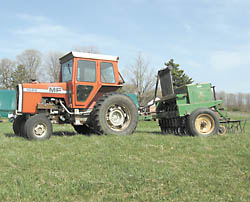
Turning tractor engine exhaust into nitrogen-rich moisture that can be injected into the ground while seeding crops isn't difficult to do, says vo-ag teacher Ray Morrison of Dobbinton, Ont.
After reading stories in FARM SHOW and elsewhere about the process, Morrison decided to adapt his 80 hp diesel tractor and Grain Plains drill.
"Given the high price of fertilizer, I thought it was an idea worth trying," says Morrison. "At first I thought the goal was to get the carbon dioxide from the exhaust into the soil. I have a brother who is an engineer, and he helped me understand that the real goal was the nitrogen."
The diesel process changes nitrogen in the air into nitrogen oxides, which plants can use. As the exhaust cools, it draws moisture out of the air, and the nitrogen oxide-rich moisture can be injected into the soil.
What Morrison needed was a radiator to cool and condense the exhaust. He designed a manifold he felt was large enough to handle his tractor's exhaust. With the help of the school's auto class and its exhaust pipe benders, the vo-ag class was able to build one without much difficulty. The manifold, or "rad" as Morrison refers to it, is mounted on the front of the grain drill. It consists of nine 48-in. tall, 3-in. diameter uprights with 4-in. spacings. The uprights were mounted between upper and lower 6-in. diameter horizontal pipes. The hot exhaust is piped to the top of the rad where it's distributed across the top of the uprights. As it moves into the manifold, it slows by a factor of ten in the larger system. This also ensures the system doesn't develop any back pressure on the engine.
At the bottom of the rad, the now cooler and wetter exhaust is distributed to the 15 seed rows and knifed into the ground.
The only change made to the tractor was to reroute the exhaust beneath the tractor and back to the outlet on the drill.
"You get a pretty steady flow of moisture out of the pipes," says Morrison. "This spring I will be making a couple of runs down my wheat fields to test the effect on yield."
FARM SHOW will follow up with Morrison this summer to get the results.
Morrison also has been cooling exhaust from his propane furnace. So far he has collected about 200 gal. of condensate, which he plans to apply to plots in a hay field.
"I know it will work; I just hope I have the right interpretation of how it will work," says Morrison.
